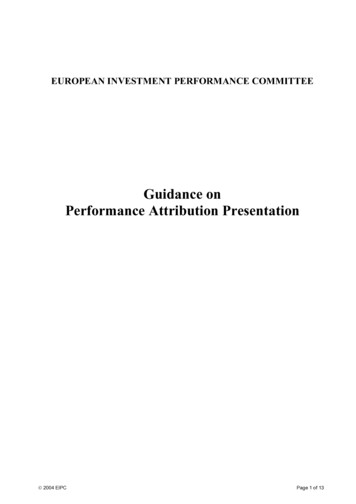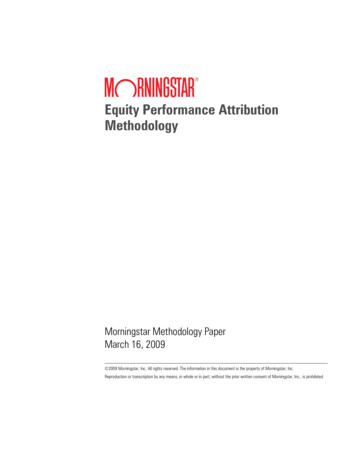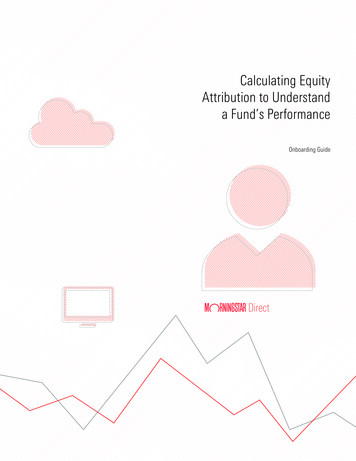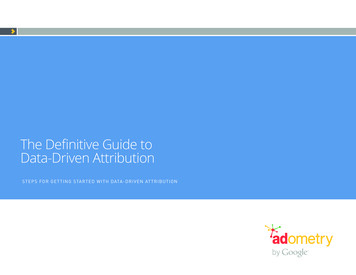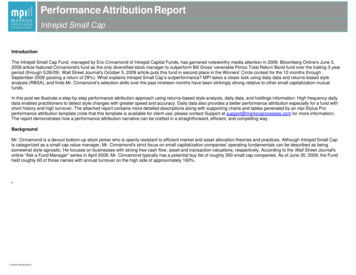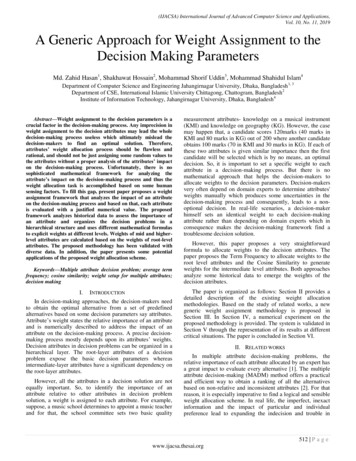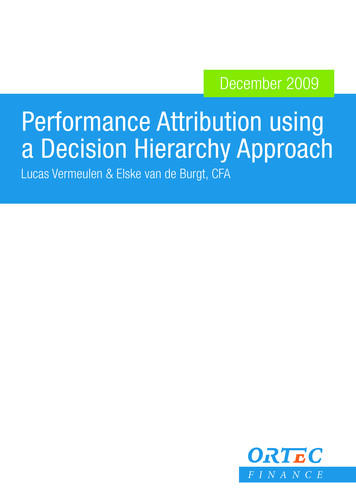
Transcription
December 2009Performance Attribution usinga Decision Hierarchy ApproachLucas Vermeulen & Elske van de Burgt, CFA
Performance Attribution using a1Decision Hierarchy Approach11INTRODUCTION2INVESTMENT DECISION PROCESS3CONCLUSIONThis article has been published in the EDHEC newsletter, December 2009
1INTRODUCTIONBrinson et al1 were the first to provide a systematic framework to quantify (what they called) allocation and selection decisions. Theirframework has become the cornerstone of performance attribution and has ruled the performance profession for over two decades. Unfortunately, the model has inherent flaws and has put analysis often on the wrong track. What is conceived on an academic’s blackboardrarely mirrors the investment decision process of today’s products and portfolios: the increasingly dynamic nature of asset allocation andthe combination of internal and external management of the total assets requires a bespoke model for deeper insight on the organization’s results. For this reason Ortec Finance, in conjunction with a major Dutch pension scheme, introduced in 2001 what we call theIDP (Investment Decision Process) model2. It provides a generic approach to evaluating investment performance that applies to virtuallyall asset classes and investment styles.Brinson G.P., L.R. Hood, and G.L. Beebower, “Determinants of Portfolio Performance”, Financial Analyst Journal, July/August 1986Geenen J., M. Heemskerk, Heerema M., Decision Based Performance Evaluation: Evaluating the Performance of a Hierarchally Structured Investment Process,Journal of Performance Measurement, Fall 2001.12
2INVESTMENT DECISION PROCESSThe most important difference between the IDP and Brinson approaches is that the latter is based on bottom-up data mining, whereasthe IDP approach starts from the management structure and follows the flow of the investments from top-down without sacrifice to thegoals set for micro attribution. Each investment management process can be visualised by a hierarchy of investment decisions, with eachdecision contributing to the overall profit or loss. It is important to realise that when money is allocated top-down, decisions on lowerlevels should have no impact on the value of the higher level (earlier made) decisions. For example, the added value of allocating moneyto a given manager should not depend on the alpha of that specific manager.In the IDP framework benchmarks naturally follow from decisions layers. Each decision serves as reference for the subsequent decisionand the value added is measured by the difference in results between the layers precisely reflecting the actual process of managing theassets. This yields an important feature of the IDP approach: the sum of added values of all decisions is equal to the overall profit orloss of the investment strategy. A simple example can be used to illustrate our hypothesis. An institutional investor has a strategic assetallocation and benchmark returns as shown in Panel 1.Panel 1 - Strategic asset allocation and benchmark returnsStrategic benchmarkWeightReturnContr. (bps)Equity35%7.40%259Fixed vesFund100%575We expect a portfolio return of approximately 5.75%. And the performance records of its 11 investment managers, shown in Panel 2reveals indeed a portfolio return of 5.75%. But they also claim a collective out-performance of 75 basis points. How to explain the twoapparently contradictory statements?
Panel 2 - Managers’ performance idend 3.67%141-6Global credit13.6%3.68%504.35%59-9Commercial 715Infrastructure2.0%0.31%15.44%11-10Absolute return0.8%12.18%1011.29%91Private y growthFundamental valueFixed incomePropertyAlternativesTotal575A classical Brinson return attribution is given in Panel 3. The analysis does not provide sufficient insight. The asset allocation effect ofminus 11 basis points is offset by the other effects. Due to the reported 75 basis points out-performance by the managers, 64 basispoints remain unaccounted for.Panel 3 - Brinson talEquity32.0%35.0%9.53%7.40%-575-663Fixed 5.75%-1116-50AlternativesFund
Panel 4 illustrates the IDP approach. The investment process consists of four decisions: strategic asset allocation (SAA), the tacticalasset allocation (TAA), style selection, and managers’ stock picking. The value of each decision is the sum of contributions from theinvestments made, which result from allocations to the various benchmarks. This is the case for all but the lowest level, at which theactual results are used to quantify the decision. The SAA, compared with a zero gain, yields a return of 575 basis points. The TAA hasa value of 564 basis points, equalling to a loss of 11 basis points, as previously illustrated. The style allocation is 500 basis points andtherefore representing a loss of 64 basis points against the TAA – precisely the result previously unaccounted for. The managers add 75basis points to the style allocation decision, completely offsetting the tactical losses.Panel 4 - IDP approachSAALevelEquityFixed rn (bps)740420600920Contribution2592106046575Value added2592106046575LevelEquityFixed turn (bps)740420600920Contribution2372187237564Value added(22)812(9)(11)LevelEquityFixed turn (bps)719385333750Contribution2302004030500Value added(7)(18)(32)(7)(64)LevelEquityFixed turn (bps)953356542500Contribution3051856520575Value added75(15)25(10)75TAASTYLEMANAGERS’ SKILL
3CONCLUSIONThe Brinson model has long dominated the toolset of performance analysts. However, in today’s asset management it falls short of providing a comprehensive analytical framework. Due to the accurate modelling of the investment management structure, the IDP methodology reveals the active investment decisions. This is a crucial benefit of correct and insightful performance evaluation, focused on continued improvement of the results. As the analysis mimics the actual investment process, the IDP approach is equally applicable acrossall asset classes and investment styles. It will resolve most of the problems perceived by today’s performance professionals, including:Allocation effect of illiquid investments.Weights of illiquid asset classes are often set as a target but they are difficult to manage. Hence an over- or underweight cannot be considered an active bet. The unintentional allocation effect is easily measured by adding a decision layer, reflecting the difference betweenintention and reality.Benchmark inconsistency and risk-adjusted performance measures.The Brinson model requires benchmark consistency. In the IDP model each decision layer is valued independently from the subsequentlayer, proceeding top down rather than bottom up.Multi-asset class portfolios.Because the IDP approach mimics the investment management structure and separates this from the actual calculations, it allows forcorrect modelling of multi asset class portfolios and allows for different treatment of different asset classes within the same framework.Overlays, absolute return, hedge funds, leveraged investments.Because the IDP approach is based on investment flows and gains, it does not suffer from the usual pitfalls when weights and returnsare not well defined.Lucas Vermeulen is UK head of Ortec Finance andElske van de Burgt is managing directorInvestment Performance within Ortec Finance.
Performance Attribution usinga Decision Hierarchy ApproachOrtec Finance bvBoompjes 403011 XB RotterdamThe NetherlandsTel. 31 (0)10 700 50 00Ortec Finance bvBarajasweg 101043 CP AmsterdamThe NetherlandsTel. 31 (0)20 700 97 00Ortec Finance Ltd23 Austin FriarsLondon EC2N 2QPUnited KingdomTel. 44 (0)20 3178 3913Ortec Finance AGPoststrasse 48808 Pfäffikon SZSwitzerlandTel. 41 (0)55 410 38 38info@ortec-finance.com www.ortec-finance.com
Panel 2 - Managers' performance records A classical Brinson return attribution is given in Panel 3. The analysis does not provide sufficient insight. The asset allocation effect of minus 11 basis points is offset by the other effects. Due to the reported 75 basis points out-performance by the managers, 64 basis points remain unaccounted for.

